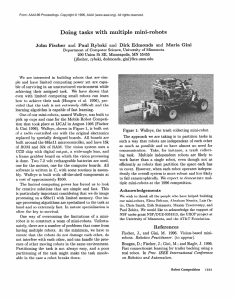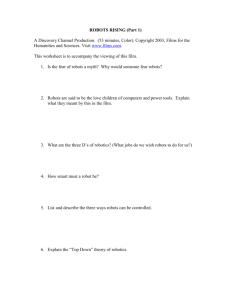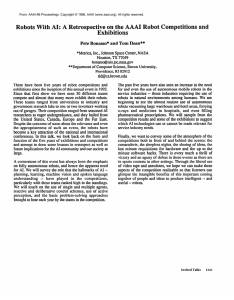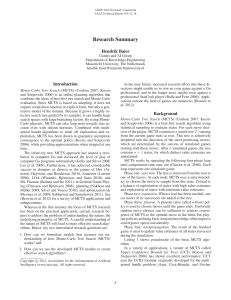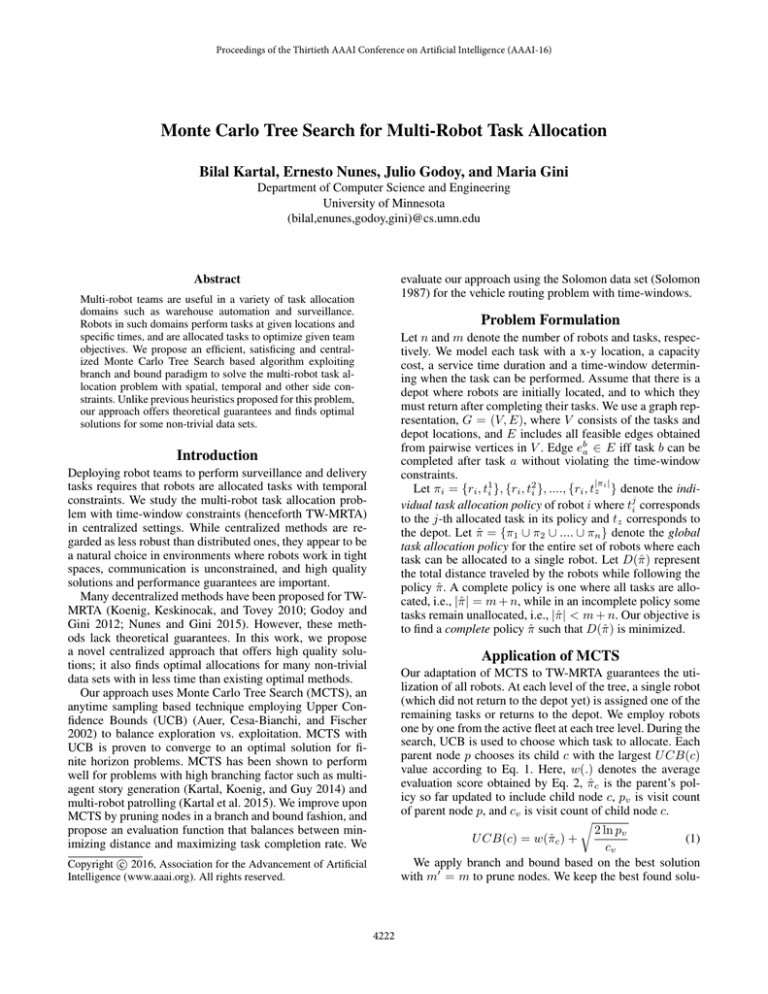
Proceedings of the Thirtieth AAAI Conference on Artificial Intelligence (AAAI-16)
Monte Carlo Tree Search for Multi-Robot Task Allocation
Bilal Kartal, Ernesto Nunes, Julio Godoy, and Maria Gini
Department of Computer Science and Engineering
University of Minnesota
(bilal,enunes,godoy,gini)@cs.umn.edu
evaluate our approach using the Solomon data set (Solomon
1987) for the vehicle routing problem with time-windows.
Abstract
Multi-robot teams are useful in a variety of task allocation
domains such as warehouse automation and surveillance.
Robots in such domains perform tasks at given locations and
specific times, and are allocated tasks to optimize given team
objectives. We propose an efficient, satisficing and centralized Monte Carlo Tree Search based algorithm exploiting
branch and bound paradigm to solve the multi-robot task allocation problem with spatial, temporal and other side constraints. Unlike previous heuristics proposed for this problem,
our approach offers theoretical guarantees and finds optimal
solutions for some non-trivial data sets.
Problem Formulation
Let n and m denote the number of robots and tasks, respectively. We model each task with a x-y location, a capacity
cost, a service time duration and a time-window determining when the task can be performed. Assume that there is a
depot where robots are initially located, and to which they
must return after completing their tasks. We use a graph representation, G = (V, E), where V consists of the tasks and
depot locations, and E includes all feasible edges obtained
from pairwise vertices in V . Edge eba ∈ E iff task b can be
completed after task a without violating the time-window
constraints.
|π |
Let πi = {ri , t1i }, {ri , t2i }, ...., {ri , tz i } denote the individual task allocation policy of robot i where tji corresponds
to the j-th allocated task in its policy and tz corresponds to
the depot. Let π̂ = {π1 ∪ π2 ∪ .... ∪ πn } denote the global
task allocation policy for the entire set of robots where each
task can be allocated to a single robot. Let D(π̂) represent
the total distance traveled by the robots while following the
policy π̂. A complete policy is one where all tasks are allocated, i.e., |π̂| = m + n, while in an incomplete policy some
tasks remain unallocated, i.e., |π̂| < m + n. Our objective is
to find a complete policy π̂ such that D(π̂) is minimized.
Introduction
Deploying robot teams to perform surveillance and delivery
tasks requires that robots are allocated tasks with temporal
constraints. We study the multi-robot task allocation problem with time-window constraints (henceforth TW-MRTA)
in centralized settings. While centralized methods are regarded as less robust than distributed ones, they appear to be
a natural choice in environments where robots work in tight
spaces, communication is unconstrained, and high quality
solutions and performance guarantees are important.
Many decentralized methods have been proposed for TWMRTA (Koenig, Keskinocak, and Tovey 2010; Godoy and
Gini 2012; Nunes and Gini 2015). However, these methods lack theoretical guarantees. In this work, we propose
a novel centralized approach that offers high quality solutions; it also finds optimal allocations for many non-trivial
data sets with in less time than existing optimal methods.
Our approach uses Monte Carlo Tree Search (MCTS), an
anytime sampling based technique employing Upper Confidence Bounds (UCB) (Auer, Cesa-Bianchi, and Fischer
2002) to balance exploration vs. exploitation. MCTS with
UCB is proven to converge to an optimal solution for finite horizon problems. MCTS has been shown to perform
well for problems with high branching factor such as multiagent story generation (Kartal, Koenig, and Guy 2014) and
multi-robot patrolling (Kartal et al. 2015). We improve upon
MCTS by pruning nodes in a branch and bound fashion, and
propose an evaluation function that balances between minimizing distance and maximizing task completion rate. We
Application of MCTS
Our adaptation of MCTS to TW-MRTA guarantees the utilization of all robots. At each level of the tree, a single robot
(which did not return to the depot yet) is assigned one of the
remaining tasks or returns to the depot. We employ robots
one by one from the active fleet at each tree level. During the
search, UCB is used to choose which task to allocate. Each
parent node p chooses its child c with the largest U CB(c)
value according to Eq. 1. Here, w(.) denotes the average
evaluation score obtained by Eq. 2, π̂c is the parent’s policy so far updated to include child node c, pv is visit count
of parent node p, and cv is visit count of child node c.
2 ln pv
(1)
U CB(c) = w(π̂c ) +
cv
We apply branch and bound based on the best solution
with m = m to prune nodes. We keep the best found solu-
c 2016, Association for the Advancement of Artificial
Copyright Intelligence (www.aaai.org). All rights reserved.
4222
easily prove this by decomposing all traveled edges, however we omit the proof due to space constraints. Also, both
D(π̂) ≤ α/2 and ψ < α, and consequently, 0.5 ≤ f (π̂) ≤ 1
holds for any complete policy π̂.
Preliminary Results
We present preliminary results (see Table 1) on a Solomon
data set with 25 tasks and three robots. For these experiments the UCB is not tuned and each experiment is run
once. Our approach quickly finds solutions completing all
the tasks, improves the distance quality, and although it takes
more time on less constrained scenarios (e.g larger timewindows), it is orders of magnitude faster than exact methods. The optimal solution found by our approach is shown
in Figure 1, where each robot is allocated to a task cluster.
Figure 1: An example of an optimal policy found by our
approach on Solomon’s (C101) data set. Ri , i ∈ {0, 1, 2}
are robots’ indices.
Scenario
MCTS
Optimal Distance
Time (in sec.)
C101
C102
C103
C104
C105
C106
C107
C108
C109
191.3
190.3
270.2
235.7
191.3
191.3
191.3
242.4
247.5
191.3
190.3
190.3
186.9
191.3
191.3
191.3
191.3
191.3
3
80
191
293
89
6
244
256
159
Conclusions and Future Work
Preliminary results show that our approach performs well for
the TW-MRTA problem, and in many instances it finds optimal allocations. For future, we plan to perform experiments
on larger problem instances, and employ search parallelization. For example, we can create multiple trees with varied
UCB exploration parameters and broadcast the best solution across all trees to expedite the pruning process. Lastly,
we plan to compare our approach with cooperative auction
based approaches (Koenig, Keskinocak, and Tovey 2010).
References
Table 1: Results on Solomon Benchmark for 25 tasks and
three robots with a maximum search time of 5 minutes.
Auer, P.; Cesa-Bianchi, N.; and Fischer, P. 2002. Finitetime analysis of the multiarmed bandit problem. Machine
Learning 47(2-3):235–256.
Godoy, J., and Gini, M. 2012. Task allocation for spatially
and temporally distributed tasks. In Proc. of the Int’l Conf.
on Intelligent Autonomous Systems, 603–612.
Kartal, B.; Godoy, J.; Karamouzas, I.; and Guy, S. J. 2015.
Stochastic tree search with useful cycles for patrolling problems. In Proc. IEEE Int’l Conf. on Robotics and Automation,
1289–1294.
Kartal, B.; Koenig, J.; and Guy, S. J. 2014. User-driven
narrative variation in large story domains using monte carlo
tree search. In Int’l Conf. on Autonomous Agents and MultiAgent Systems, 69–76.
Koenig, S.; Keskinocak, P.; and Tovey, C. A. 2010. Progress
on agent coordination with cooperative auctions. In TwentyFourth AAAI Conference on Artificial Intelligence, 1713–
1717.
Nunes, E., and Gini, M. 2015. Multi-robot auctions for allocation of tasks with temporal constraints. In Twenty-Ninth
AAAI Conference on Artificial Intelligence, 2110 –2116.
Solomon, M. M. 1987. Algorithms for the vehicle routing and scheduling problems with time window constraints.
Operations Research 35(2):254–265.
tion during the search and halt the search with a threshold by
exploiting the anytime property of MCTS. Once the search
is over, the solution π̂ is decomposed into n individual robot
policies to be executed simultaneously.
Policy Evaluation Function
We propose a policy evaluation function that guarantees that
with more planning time, MCTS will find better solutions.
Let α denote a loose upper bound on the total traveled distance D(π̂), and Ê be a sorted version of E (in descending
m+n
order of their distances). Then, α = 2 × i=1 ei where
ei ∈ Ê. To discourage incomplete policies, we define a negative reward parameter, ψ, which is computed as follows:
m−m
ψ = 2 × i=1 ei , ei ∈ E , where m denotes the number
of completed tasks, and E ⊂ E is the set of edges directed
from completed to uncompleted tasks and from uncompleted
to the depot, sorted in descending order of their distances.
Based on these definitions, we propose an evaluation function f (π̂), to assess policy π̂, as follows:
α − (D(π̂) + ψ) m
×
(2)
α
m
Our evaluation function is monotone: for every optimally
allocated task, the actual traveled distance increases by some
c ≥ 0, while ψ decreases by at least c; this guarantees that
the evaluation score of the policy never decreases. We can
f (π̂) =
4223



